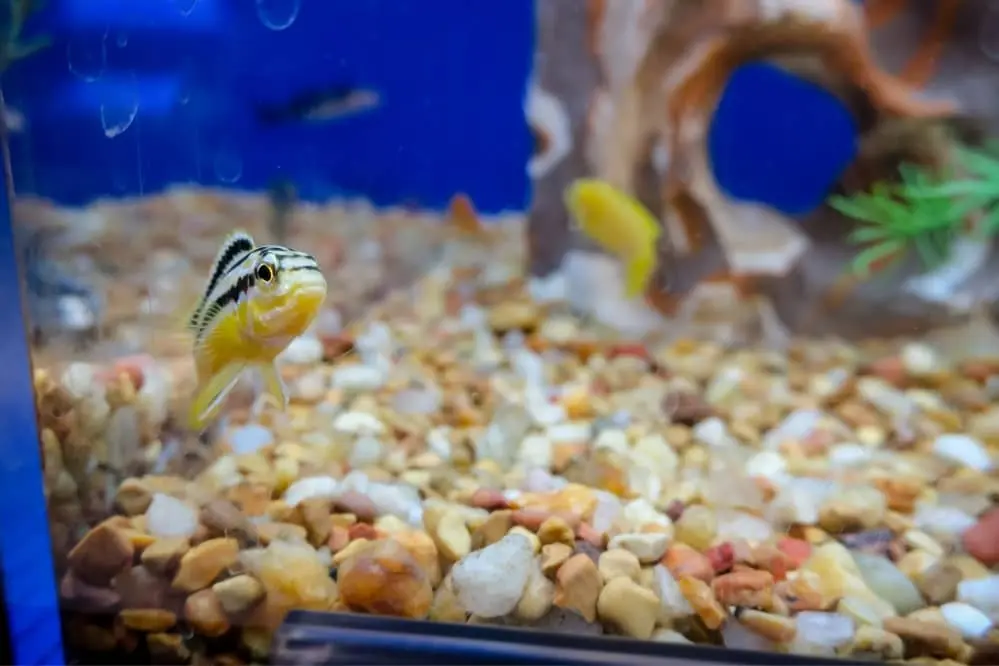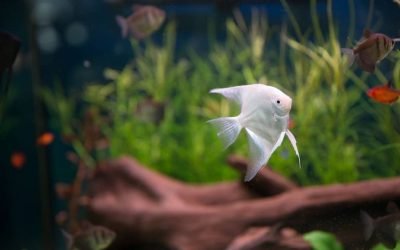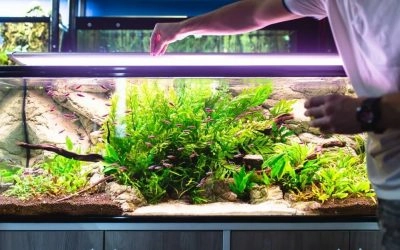How do I increase Oxygen in My Fish Tank? 7 Simple Tips

Fish need oxygen in their tank, and the amount needed varies depending on the fish and a few other factors. As a general rule, however, it is recommended to have five parts per million (PPM) of dissolved oxygen in your fish tank. In fact, you should never let that number get below two PPM because your fish can actually start to suffocate. If your fish are lethargic or show signs of having trouble breathing, it usually means you don’t have enough oxygen, but learning how to increase oxygen in a fish tank is as simple as the following tips.
1. Ensure the Water Temperature Is at the Right Level
Checking the temperature of your tank’s water on a regular basis is highly recommended. If your water temperature is too high, the oxygen inside of the tank can get too low. For this problem, remedies include purchasing an aquarium chiller to reduce the water temperature, turning off the light inside of the tank for a while, removing the lid of the tank, using a fan to blow across the water in the tank, and making sure your tank is always away from direct sunlight.
Numerous things can increase your water temperature, and checking it is the first step to reducing that temperature. If you change the water in your tank more frequently, making sure you add lots of cool water as you do this can help as well.
2. Clean Your Tank Frequently – and Properly
Clean your tank thoroughly without using any soap or chemicals, and remove everything inside of the tank before you get started. Wipe down the sides of the tank with a paper towel, and use an old toothbrush to clean all of the decorative pieces. In short, complete each step of the cleaning process the way it’s supposed to be completed, and only use fresh water when refilling the tank. If your tank isn’t being cleaned properly or often enough, it can disrupt the oxygen levels inside, which is why it needs to be done so often.
It may take some time to clean the fish tank properly, but it is always well worth it in the end, and you’ll worry less about the oxygen levels in the meantime.
3. Be Careful with Any Treatments or Additives You Use
Before you add anything to the water of your fish tank, you need to check the instructions to make sure it doesn’t interfere with the oxygen levels in the water. If you’ve already added some type of treatment, read the label that came with it and replace the treatment immediately if necessary. This information should be clearly indicated in the instructions or description of the treatment you’re using, so you should be able to determine if the product is going to interfere in any way with the oxygen levels in your fish tank.
Signs of low oxygen in an aquarium include fish hanging out around the filter at the point where it puts water back into the tank and even looking off-balance when they swim.
4. Make Sure There Is Movement in the Water
Movement in the water of your fish tank creates more oxygen, and you can do this any number of ways. First of all, you can add a powerhead so that there is consistent movement in the water. In fact, there are a number of accessories and decorative parts that you can add to your fish tank that move and create motion. Not only are they great for adding more water movement, but they make the tank more attractive as well. If your tank is large, you could consider adding more than one powerhead and placing them on opposite sides of the tank so that the water movement is more even and consistent.
5. Make Sure the Tank Isn’t Overcrowded
Before you ask yourself, how do I add oxygen to my fish tank, you have to first ask, what is the cause of there being too little oxygen? One of the most common reasons is overcrowding; in other words, you simply have too many fish in your aquarium. There are a lot of rules for what the fish-to-water ratio should be, but a very general rule is to include one gallon of water for every one inch of fish that you have. If your ratio is different and you have too many fish in your tank, you can simply add them to another tank. When too many fish are in an aquarium, they have to compete for the oxygen that’s there, and it’s very likely there won’t be enough oxygen to sustain all of the fish.
6. Does Your Aquarium Contain Live Plants?
While it is true that live plants will oxygenate the water, if you have live plants and not enough lighting, the plants may start to release carbon dioxide instead of oxygen. If you have live plants in your aquarium yet the lighting is too low, plants releasing carbon dioxide is a distinct possibility. If you feel that there is not enough oxygen in your tank and you have live plants and no lighting, make sure you add some lighting to the tank. Make sure you add enough lighting because the more live plants you have, the more lighting you’ll need. Otherwise, the plants will take in oxygen and release carbon dioxide, instead of doing it the other way around like they’re supposed to.
7. If Your Water Is Too Warm – An Emergency Measure
If you discover that your water is too warm and you’re interested in a quick and temporary measure to cool it down some, simply put some ice cubes in a closeable bag and place the bag inside of the water until it cools down. This isn’t a permanent measure, nor should it be done all the time, but it is good in a pinch when you want the water temperature to go down without adding more water to the tank. If you think you’re overdoing it, don’t panic. A lot of people wonder, can you have too much oxygen in a fish tank, but the truth is that this is extremely unlikely. More often than not, the problem is too little oxygen instead of too much.




0 Comments